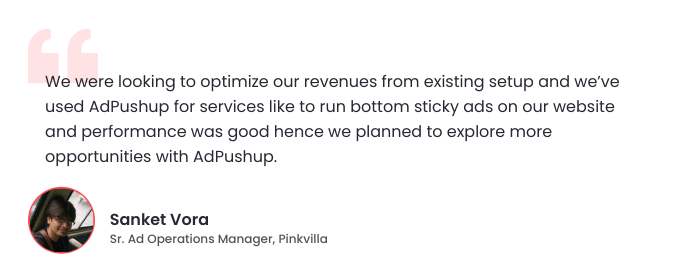In the ever-evolving world of digital marketing, maximizing the potential of your website’s traffic and to strategically monetizing your website traffic is crucial for sustainable online success. As we gradually leave 2023 behind us and step into 2024, the dynamics of website monetization continue to evolve.
As evident by the graph above, Web 3.0 will continue to see an increase in market size, offering website owners and businesses numerous reasons to convert web traffic into revenue. This means that there will be a lot of new ways to monetize your website in 2023 and beyond. But what happens with its traffic as a standalone metric?
This comprehensive guide will explore seven effective ways to monetize web traffic in 2023, delving into techniques, statistics, and compelling reasons for choosing each approach.
The Ways to Monetize Your Web Traffic in 2023
Monetizing your web traffic comes in various forms. As we all know, web traffic monetization is the process of generating revenue from the traffic your website attracts. This can encompass strategies and techniques to turn your website’s visitors into paying customers, subscribers, or engaged users.
Let’s see the seven most popular of them.
Through Email Marketing
When it comes to monetizing your web traffic, email marketing remains one of the most potent tools in 2023. Here’s why:
With more than 4 billion email users and an impressive and fully measurable ROI, email marketing is one of the mediums that offer a direct and highly personalized approach to engaging your audience and converting web traffic into revenue.
But how would you use email marketing as a website monetization strategy?
The first thing to keep in mind is that you’ll need to invest in an email marketing and marketing automation platform that allows you to automate your efforts. Features, like triggered email campaigns, are among the most sought-after in platforms like Mailchimp and its alternatives for a specific reason: They can save time and effort seamlessly and allow marketers to put their efforts in more complicated campaigns.
Through the right email automation platforms, you can create automated workflows for welcoming new subscribers, reminding customers of abandoned shopping carts, or following up after a purchase.
Generally speaking, email automation can help you monetize your web traffic, as its conversion is higher:
Of course, automated campaigns nurture leads and customers and nudge them further down the sales funnel. Still, they aren’t the only thing an email marketing and marketing automation platform should sport to increase conversion and boost web traffic monetization.
Segmentation is just as important regarding email marketing techniques for web traffic monetization in 2023 – and beyond. In layman’s terms, segmentation involves breaking down your email list into distinct segments based on various factors such as demographics, user behavior, purchase history, or engagement level.
Segmenting your leads will allow you to send highly targeted and personalized email campaigns to different groups within your audience, ensuring that your subscribers receive content and offers that are relevant to their interests and needs.
And here’s what it can do for your website traffic:
After segmenting your audience, it’s time to personalize your content. In 2023 personalized experiences are a necessity, and email marketing excels in delivering tailored content. With segmentation and personalization, you can send highly relevant messages to different segments of your audience.
Make sure your personalization strategy goes beyond a “Hello [First Name]” and includes delivering content that resonates with their specific interests, preferences, and behaviors. When subscribers receive emails that feel tailor-made, they are more likely to engage and take desired actions.
But what other reasons are there to prove that email marketing is an effective way to monetize your website traffic?
- It’s direct. Email marketing offers a direct line of communication with your audience. Unlike social media or search engine algorithms, choosing one of the best email marketing services helps your messages reach your audience without intermediary filters. This direct connection can build strong relationships, nurture leads, and convert web traffic into paying customers.
- It’s cost-effective. You don’t need a massive budget to get started, and the return on investment (ROI) can be substantial when executed well. Therefore knowing email marketing costs helps you choose the right automation platform for your needs and budget
- It builds long-term relationships. Email marketing is not just about quick conversions. When subscribers willingly share their email addresses with you, they signal a level of interest in your brand or content. Delivering value through email campaigns will nurture this interest and turn subscribers into loyal customers while honoring the trust they showed your brand.
- It boosts recurring revenue. Long-term relationships translate into recurring revenue, customer advocacy, and reduced acquisition costs, making email marketing a sustainable monetization strategy.
The direct and cost-effective nature of email marketing and its ability to build long-term relationships and deliver personalized content make it a compelling choice for website monetization. But is that all?
Through Ads
Ads are a cornerstone technique when it comes to website monetization, mainly because they’re reliable and effective. However, there have been lots of instances where users don’t trust ads quite like they used to.
Of course, this doesn’t mean that ads are not effective, so long as they’re done following the right techniques and strategies of online advertising.
Display ads are the first thing that comes to mind when we’re talking about web traffic monetization. They involve placing banner-style ads on your website, typically in the header, footer, sidebar, or within the body of your content. Advertisers pay you based on the number of times an ad is viewed – also known as impressions – and the clicks.
Generally speaking, display ads are relatively easy to implement, making them accessible to website owners. Additionally, they can generate revenue as long as your website attracts traffic, regardless of whether users make purchases.
Another monetization technique through ads is the PPC ads technique. PPC ads are a subcategory of display ads, where advertisers pay every time a user clicks on the ad. These ads are often contextually relevant to your website’s content and can generate substantial revenue. But with a small twist.
PPC ads need a high traffic volume to be fruitful and work to their full potential. If you’re a part of a lucrative niche, such as a highly popular eCommerce store, PPC can and will work for you. To track and optimize the performance, consider exploring PPC dashboards for insightful analytics and better management.
The third ad technique for web traffic monetization is native advertising. Native ads seamlessly blend with your website’s content, appearing as natural recommendations rather than traditional advertisements. They look like this:
They are often marked as “sponsored” or “recommended” content and are as seamless as an ad could be. Native ads can include articles, product recommendations, or content straight from your YouTube channel.
In general, native ads are preferred because of their non-intrusive nature. They provide a seamless experience for your users and have a higher click-through rate because they match the look and feel of your website.
Lastly, video ads are a perfect, highly engaging way to monetize your website traffic. Use video content, such as pre-roll or mid-roll ads, within your website’s video or article content. Advertisers pay you based on video views, clicks, or completed views.
Video ads are highly engaging and can score higher ad rates than traditional display ads. They are effective for websites with video content or engaging multimedia experiences.
But there is a question to be answered here. What are the core reasons a brand should choose ads to monetize website traffic?
- They provide immediate results. One of the most significant advantages of using ads for website monetization is the ability to generate revenue quickly. You can start earning money as soon as you implement ads and attract traffic. This is perfect if you’re looking for a relatively fast return on investment.
- They’re extremely targeted. Modern advertising platforms utilize sophisticated algorithms to serve ads that are relevant to both your website’s content and your users’ interests. This targeted advertising ensures that users are more interested and engaged as they see something they already care about. This, in turn, can lead to higher click-through rates and increased revenue.
- Ads come in many different forms. You can diversify your revenue streams by incorporating various ads on your website. For example, you can use display ads in sidebars, native ads within content, and video ads for multimedia content. This diversification can help you maximize your earnings from different sources.
- They’re scalable. As your website’s traffic grows, so does your potential for ad revenue. Unlike monetization methods that require creating and selling products or services, ads scale with your audience. The more visitors you attract, the better the chances of ad impressions and clicks.
Monetizing website traffic through ads offers immediate revenue; the more targeted the ad, the better for your income. However, ads are not the only thing that can help you provide an exceptional experience to your traffic and turn users into buyers.

Through Sponsored Content and Guest Posts
Sponsored content and guest posts are two strategies that have gone relatively unnoticed for the past few years, compared to ads and email marketing. However, monetizing your content marketing efforts is something that can bring you a lot of revenue in 2023, especially through your web traffic.
But let’s define the types of content we’re talking about:
- Sponsored content is content created in collaboration with sponsors. They can be blog posts, infographics, or videos. These posts typically feature products, services, or topics related to the sponsor’s niche. They are integrated into your content flow while maintaining relevance and value to your readers.
- Guest posts are contributed by external writers or experts in your field. They offer fresh perspectives, valuable insights, and diverse voices to your website. Guest posts can either be unpaid or sponsored.
Generally speaking, content marketing can contribute to enhancing your website’s value and authority within your niche. But let’s see how you can also monetize your efforts through sponsored and guest content.
The first thing to do would be to be highly selective with your prospective partners. When pursuing sponsored content opportunities or guest posts, it’s vital to choose partners and brands that align with your website’s niche and values.
Look for brands whose products or services genuinely benefit your audience. This alignment ensures that your content feels organic and valuable to your readers, whether discussing sponsored content or a guest author in your blog.
Also, guest posts specifically can boost traffic, giving you more monetization opportunities:
The second thing you should consider when talking about sponsored or guest content is transparency. Disclose when content is sponsored or from a guest author. It will build trust and credibility between your brand and your readers. It will also help your audience understand that sponsored content is provided for informational or promotional purposes.
Being transparent with your goals and techniques is essential when you’re trying to monetize website traffic. It builds credibility and fosters reader trust. Not to mention how it can give them – and you – extra data on how to pick and choose the types of content they’ll engage with. That data can transform into something else, be it an email marketing campaign or a webinar collaboration.
The third thing you need to ensure when collaborating with guests for sponsored content and guest blogging is quality. Ensure that sponsored articles align with your brand’s tone, style, and quality standards. Collaborate closely with guest authors and brands to produce content that provides real value to your audience.
High-quality content reflects positively on your website’s reputation and maintains the interest of your audience. It ensures that readers continue to engage with your content and trust your recommendations.
But why does sponsored and guest content work, exactly?
- Additional revenue streams. Sponsored content and guest posts provide an additional revenue stream beyond traditional advertising or product sales. They can reduce your dependence on a single source of revenue.
- Better website and brand authority. When you collaborate with reputable sponsors or guest contributors, you boost your website’s authority. Readers will come to think of your website as a valuable source of diverse information when it features content from recognized experts or businesses.
- Establishing your brand as an expert. Sponsored content and guest posts introduce fresh perspectives and expertise to your website while different voices and viewpoints keep your content diverse and engaging.
- Improves SEO and traffic. Quality sponsored content and guest posts can attract a new audience and enhance your website’s SEO efforts. When optimized, these posts can rank for relevant keywords, driving organic traffic to your site.
- Mutually beneficial partnerships. Sponsored content and guest post arrangements are often mutually beneficial. Partners gain exposure to your audience, while you receive compensation or valuable content. These partnerships can lead to long-term relationships and continued collaborations.
Generally speaking, sponsored content and guest posts allow brands to monetize their traffic while providing additional value to users. Carefully selected partnerships create transparency and prioritize content quality. At the same time both brands gain more exposure to a diverse set of individuals and can be an additional source of revenue.
Through Content Subscriptions
Content subscriptions and sponsored content are two different techniques. When marketers talk about sponsored content, they talk about content that’s typically hidden behind a paywall. Exclusive content is a great content marketing tool that can help you monetize your web traffic, as evident by the way the New York Times have used it:
However, this comes with specific techniques and a dedicated toolset as well.
Make sure to be diverse when you’re offering paid content. Attracting subscribers isn’t easy, and it’s best to be well aware of the types of content that appeal to your audience. Creating only articles or whitepapers and leaving out audio or video content with influencer tips and tricks could cost you a wide chunk of your website traffic.
Also, make sure to create private communities like members-only forums that users will be able to access only through your mailing list.
And since we’re talking about a mailing list, make sure to create various subscription plans. Each plan can foster specific access to premium content. For example, your lowest tier could provide five pieces of content per month, your mid-tier could come with an early bird admission, and your premium tier could come with content that is heavily personalized or exclusive live events.
Tiered content subscriptions can allow users to pick and choose according to their needs and their budget, so long as it’s done correctly. Remember that a low tier subscription doesn’t provide a free pass to low-value content or infrequent content updates.
But what are the types of content you could utilize in a subscription-based model? The answer to that is hidden in your audience data:
You can’t go wrong with a blog post when it comes to Millennials, but, apparently, audiobooks are not exactly their thing.
But what benefit does a content subscription model really provide when it comes to monetizing web traffic in 2023?
- Content subscriptions provide a stable source of recurring revenue. Once subscribers commit to your content, you can predict your income more accurately, reducing the uncertainty associated with other monetization methods such as social media.
- Content subscriptions create a dedicated community. Subscribers are willing to invest in your content because they value your expertise and the exclusivity of your offerings. This loyal community can become brand advocates that promote your brand to a broader audience.
- It generates more value. Subscribers expect premium content in exchange for their subscription fees. This drives you to continually produce high-quality material. And high quality always attracts more subscribers.
- It improves ownership. Content subscriptions allow your brand to maintain control over your content and monetization strategy, as opposed to paid ads or influencer marketing strategies.
- It’s scalable. As your subscriber base grows, your revenue potentially increases. Scaling your content subscription model should come easy after analyzing your data and your recurring revenue.
Content subscriptions generate revenue for website owners, and they’re a foolproof method to monetize your web traffic. However, to get a sustainable revenue from this method, you’ll need to clean your list regularly and maintain an interested and engaged audience.
Through Affiliate Marketing
Affiliate marketing is a win-win strategy for monetizing your website traffic, as it benefits both your brand and those who choose to become brand ambassadors.
Generally speaking, affiliate marketing allows brands to reach wider audiences, while affiliates earn commissions by promoting products and services.
As you can see, the numbers are impressive, as affiliate marketing has become one of the core ways of web traffic monetization. But how are you going to achieve revenue through affiliates? Commissions might be a little counterintuitive when it comes to your revenue, and, as the statistic above states, affiliate marketing fraud is a costly business.
The first thing to do would be to choose the right partners. Successful affiliate marketing depends on the relevance of the products or services you promote. Start an affiliate program by selecting partners whose overall promotions align with your brand’s niche. This ensures that your promotions feel authentic and resonate with your audience.
Remember that irrelevant affiliate partnerships can destroy the trust you’ve built with your audience and diminish the user’s experience. Visitors are more likely to engage with and convert on products or services they find valuable.
Of course, we’re not dealing with a “build it and they will come” situation here. Your second step should be high-quality, informative content. Craft compelling product reviews, comparison guides, tutorials, or infographics that provide genuine value to your audience. Make sure your affiliate partners use your materials and highlight the benefits and features of the product or service you’re promoting. That way, your users will engage with your content and affiliates will be eager to promote your products and earn more.
Another necessary step is being transparent with your audience. Make sure to pinpoint affiliate partnerships as such. Being transparent builds trust and ensures that prospects understand there’s a financial aspect to the recommendations of their favorite influencer.
As mentioned before, being transparent fosters credibility and authenticity. Users appreciate honesty, and honesty makes them more likely to trust your affiliates’ recommendations.
But putting all these aside, there has to be a reason why brands trust affiliate marketing so much as to make it a business worth more than $17 billion, according to OptinMonster.
Let’s see what those reasons are.
- Affiliate marketing is for all brands and businesses. Regardless of their niche, audience size, or technical expertise, affiliate marketing can be applied whether you’re an eCommerce professional or a SaaS business. You can start promoting affiliate products or services with minimal upfront costs and enough revenue to help you grow.
- Much like ads, affiliate marketing allows you to diversify your revenue streams and not rely on just one source of income.
- Generates passive income. Once you create quality content and establish affiliate partnerships, passive income is next. As long as your content remains relevant and continues to attract traffic, you can monetize your website traffic without constant involvement.
Affiliate marketing is a flexible strategy that can monetize website traffic. By choosing relevant affiliate partners, creating high-quality content, and maintaining transparency with your audience, you can effectively generate revenue while providing value.
Through Exclusive Digital Products
Creating and selling exclusive digital products is another foolproof way to monetize your website traffic in 2023. Exclusive digital products can range from downloadable materials to tools or webinars and courses.
The rise of the digital marketplace, as shown above, has played a significant role in the importance of digital products for web traffic monetization. Of course, as with every methodology, there are some steps you need to follow.
First of all, you need to ensure you really know your niche and your audience. Understanding what your audience wants will help you manage your resources effectively and come up with a product that makes sense to their needs and preferences – if there are any, of course. Conduct research and understand what your pain points are and whether or not a digital product can address them effectively.
Tailor-made products that provide real solutions to real problems and address your audience’s specific needs interest prospective buyers and help you create something that will generate real revenue.
Second in order of business would be the quality of your product, provided you’ve come up with one that makes sense to your users. Whether it’s an ebook, an online course, or a SaaS product, prioritize quality. Your products should provide unique value and solutions.
High-quality products not only attract new leads, but also lead to positive reviews, word-of-mouth referrals, repeaters, and upsell and cross-sell opportunities.
Of course, there is no one-size-fits-all mentality when it comes to website monetization through digital products. And since we’re talking about a digital and not a physical product, diversifying its functions to meet the needs of specific segments of your audience isn’t as difficult or costly as it could be with a pair of shoes, for example. Create different offers and tools to cater to different preferences. For example, if you’re creating educational content, offer whitepapers, video courses, and downloadable resources to accommodate various learning styles. If you’re offering digital goods like tools or infographics, make sure to understand what users will need from you and what your tools will cover.
Multiple digital product formats can widen your potential customer base and ensure that your products appeal to a broader audience.
However, monetizing your web traffic through digital product creation and offering could pose an important question: Why should you use this method?
Here are the three core reasons why you should consider using exclusive digital products for your web traffic monetization:
- The profit margin. Exclusive web products offer substantial profit margins compared to physical products. Digital products have low production cost – if any – and zero shipping costs, and will never be out of stock, making repeated purchases a possibility.
- They boost your authority. If you have expertise or authority within your niche, creating exclusive web products allows you to leverage your knowledge. Your audience is more likely to trust and invest in products created by an industry expert.
- They don’t need active involvement. Exclusive digital products can generate passive income. Once your products are available for purchase, you can continue to earn revenue without actively selling them, allowing you to focus on other aspects of your website or business.
Of course, as with all tactics, exclusive digital products could not make sense for your niche. Make sure you study your audience and your goals before creating a digital product that will be hidden behind a paywall or will be accessible to a specific segment of your audience.
Through Social Media and Influencer Marketing
Social media marketing and influencer marketing are two techniques that every brand uses nowadays, as they can transform your website traffic into a measurable source of income.
However, in today’s digital age, marketers sometimes tend to overlook the hows and whys of influencer marketing and focus only on the expected revenue, forgetting necessary steps along the way.
Some businesses thrive with social media marketing, others when they create email copy that converts, and others rely solely on word-of-mouth. However, if you’ve decided you need to leverage social media and influencer marketing, check out the essential techniques you should utilize.
First of all, create valuable content that resonates with your audience. Promoting your website content isn’t easy, especially on mediums that have parameters that are out of your control – in this case, the social media algorithms. Create and share eye-catching visuals and relevant, engaging content as consistently as possible, utilize hashtags and make calculated moves when it comes to identifying influencers.
The influencers you collaborate with should be those whose audience aligns with your website’s target demographic.
Once you’ve identified them, work closely with them and create authentic and engaging content that showcases your website or products. Influencers can provide valuable testimonials and reviews to their followers, driving traffic to your site.
Valuable content and influencers that make sense will help you build a loyal following. This user base will eventually engage with your brand on social media. Respond to comments, ask questions, and host interactive events like live Q&A sessions or polls.
Engaged followers are more likely to click through to your website, whether it’s through an influencer’s campaign or through your own social media profiles.
However, never forget that social media and influencer marketing are a little tricky. Make sure you track and measure, and that your efforts make sense for your brand. Use trackable links and codes to monitor the traffic generated by influencers. That way, you’ll have all the data you need to determine the effectiveness of your campaigns and your ROI.
Social media and influencer marketing are two techniques that provide a level of one-on-one interaction with the audience, provided the brand does it correctly. Here are the reasons why you should check if this web traffic monetization method is for you:
- Social media platforms have billions of active users. This makes it easy for brands to reach wider audiences and influence a larger slice of the prospect pie.
- Social media marketing allows precise targeting. Paid ads, dedicated content, and influencer marketing ensure your content reaches those most likely to engage and convert. Use relevant tools like social media analytic tools to run effective campaigns
- It’s authentic. Influencers and brands have built trust with their audience, making their recommendations more credible.
- It’s more engaging. Users love to have one-on-ones with their favorite brands and influencers. This makes such content more potent and helps score higher rates of engagement.
- Influencers provide better reach. Since their audience is diverse but similar to yours, influencer marketing can help you reach more users and score better with different audiences that could be interested in your product.
Monetizing website traffic through social media and influencer marketing is a great strategy, provided it’s fitting for your niche. By leveraging the power of social media and partnering with influencers, you can boost your bottom line and monetize your website traffic by leading a diverse audience straight where you want it – your website and product pages.
The Takeaway
The digital marketing landscape will forever change, but will always offer plenty of opportunities to monetize web traffic and diverse methodologies to hook your audience right off the bat.
Always keep in mind that success lies in understanding your audience, delivering value, and remaining on top of trends. By embracing these seven ways to monetize web traffic, you’ll not only increase your revenue but also foster a sustainable online presence that can thrive in the digital landscape of 2023 and beyond.







